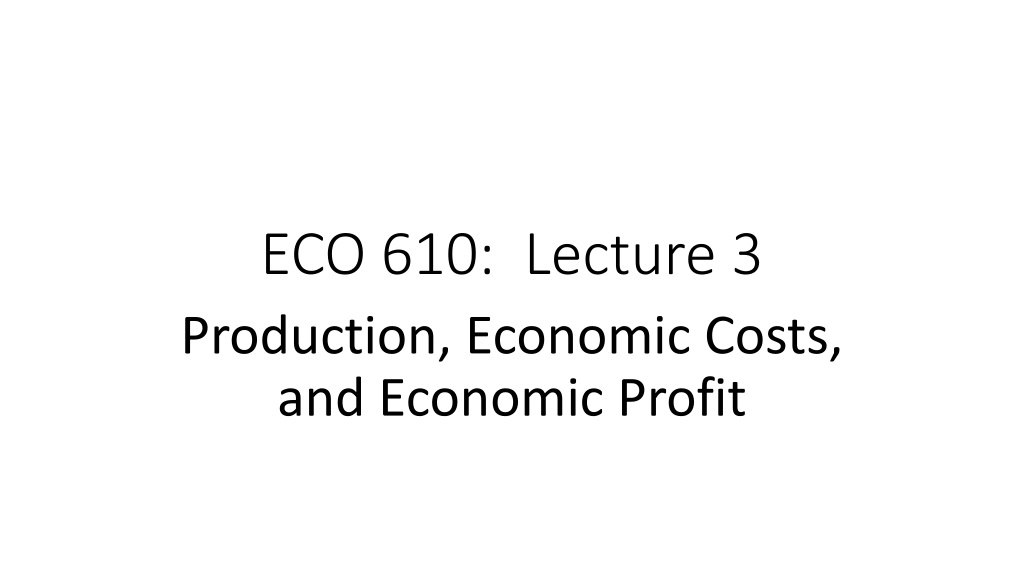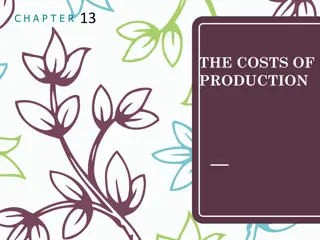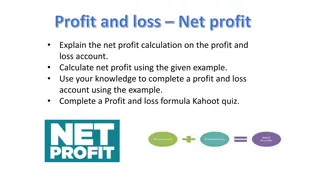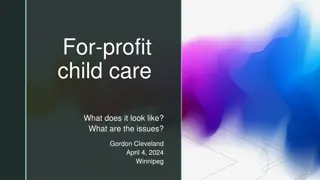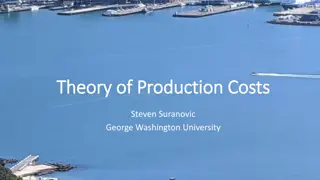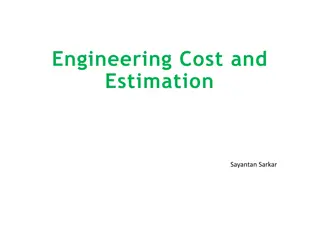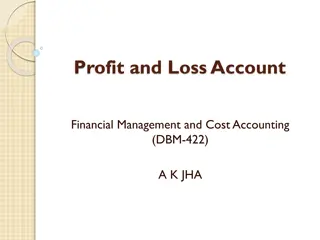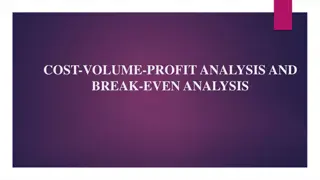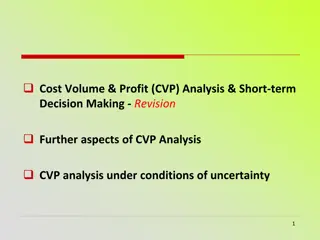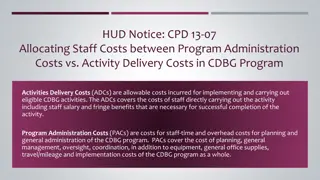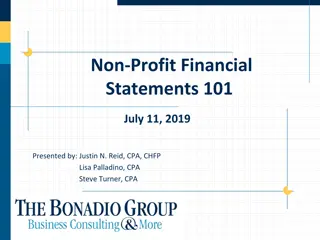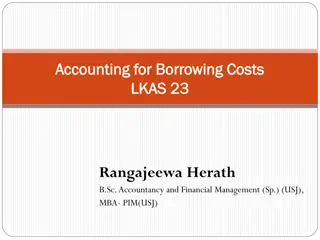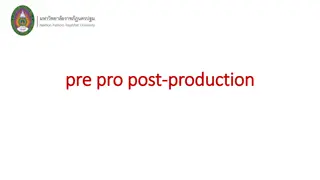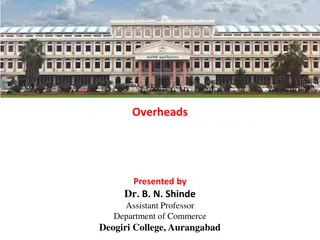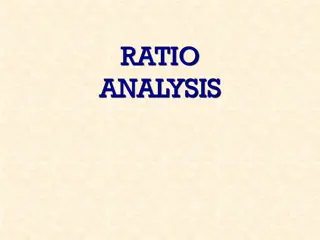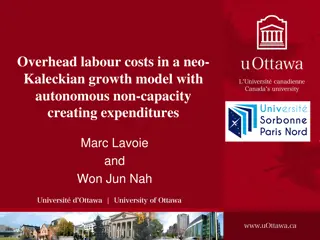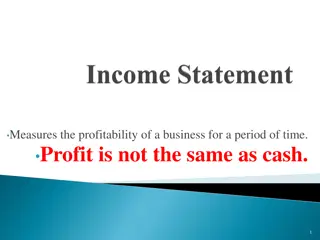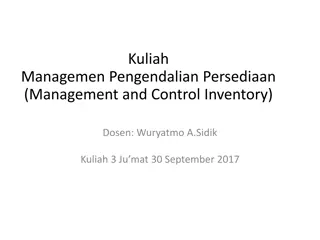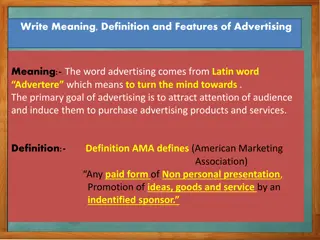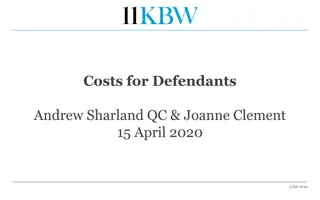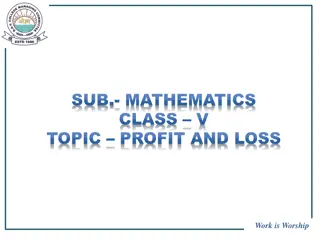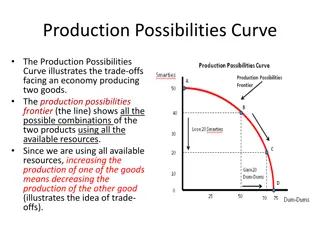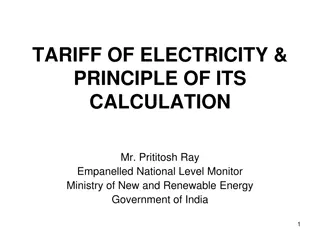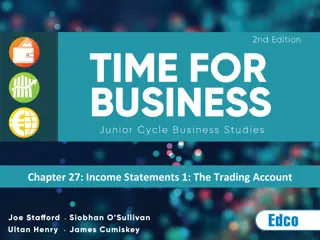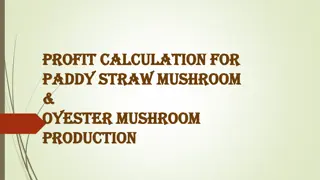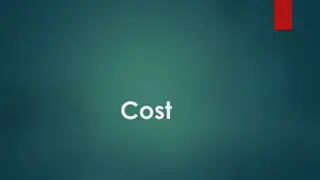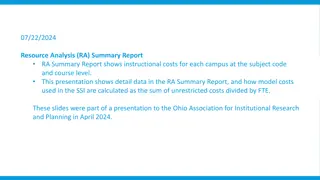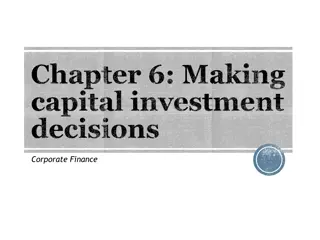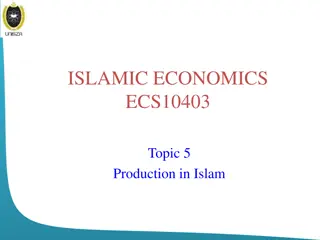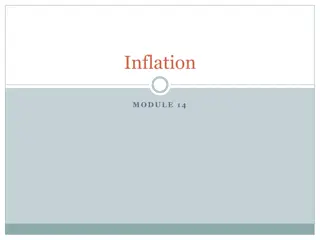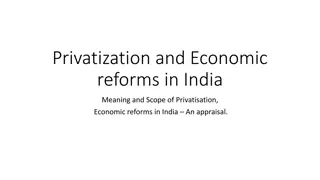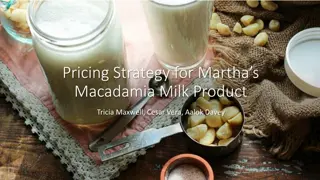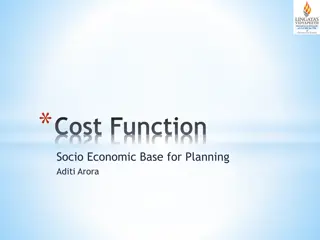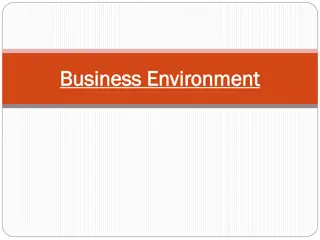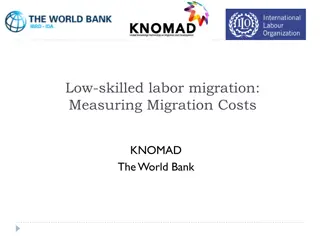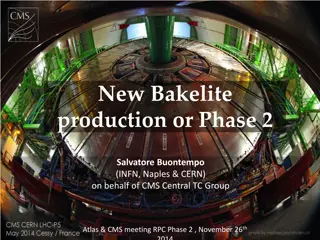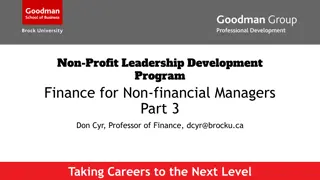Understanding Production, Economic Costs, and Profit Decisions
This lecture explores how firms make supply decisions by transforming inputs into outputs, incurring costs, and generating revenues to maximize profits. Topics covered include production theory, cost theory, economic profits, and short-run production relationships. Examples like managing a fast-food restaurant and adapting to changes in demand illustrate the principles discussed.
Download Presentation

Please find below an Image/Link to download the presentation.
The content on the website is provided AS IS for your information and personal use only. It may not be sold, licensed, or shared on other websites without obtaining consent from the author. Download presentation by click this link. If you encounter any issues during the download, it is possible that the publisher has removed the file from their server.
E N D
Presentation Transcript
ECO 610: Lecture 3 Production, Economic Costs, and Economic Profit
Production, Economic Costs, Economic Profit Goal of this section: to understand the supply decisions of firms Firms take inputs and transform them into outputs Firms use of scarce inputs causes them to incur costs Firms sale of their outputs generates revenues Firms challenge is to choose outputs that maximize profits Related to that challenge is to employ inputs so as to minimize the cost of producing the chosen outputs This requires us to understand production theory, cost theory, and the concept of economic profits
Production Theory Production is the act of transforming inputs into outputs Production function: describes the relationship between inputs and outputs General form: (y1, y2, . . ., yn) = f(x1, x2, . . ., xn) where the y s are the firm s outputs and the x s are the firm s inputs. Toyota s y s and x s? Simple form: Q = f(L, K) where Q represents the firm s output and L and K represent the firm s inputs. Me (L), my lawn mower (K), and acres of grass mowed (Q)?
Types of production decisions managers make Imagine yourself the owner/manager of a fast-food restaurant on the corner of Colfax and South Limestone. You get a phone call asking you if you can accommodate three busloads of senior citizens for lunch tomorrow at 12:30 p.m. This would at least double your usual rate of output during the lunch rush. How would you vary your use of inputs to accomplish this? https://www.youtube.com/watch?v=Xedkk1xvgeo ; https://www.youtube.com/watch?v=FXrgYbT_0sA Alternatively, you read in the paper that UK plans to add 10,000 students over the next five years. You anticipate this will add 40% or more to your daily output. How would you vary your use of inputs to accommodate this increase in demand? http://discoverarbys.com/blog/arbys-restaurant-design-smart-inviting/
Short-run production relationships Short run: different inputs can be varied over different time horizons. Depending on the time horizon over which the firm wants to vary output, it may not be able to alter the amounts of all inputs. The short run is a time period so short that the firm is unable to alter the amounts of all inputs. Fixed inputs cannot be varied over the production time period. Variable inputs can be varied over the production time period. Short-run production function: Q = f(L, ). Capital ( ) is fixed but labor (L) can be varied, so increases in output can only be achieved by adding more labor to the fixed amount of capital. In your fast-food restaurant, what inputs are fixed and what inputs are variable over a 24-hour time horizon? Can you think of a production process where L is the least variable input (i.e. fixed)? (hint: think UK)
Law of diminishing returns As we add more and more labor to a fixed amount of capital, what do we expect to happen to output? Let Q = # of meals per hour produced in your restaurant, represent the fixed capital embodied in the restaurant, and L represent the # of person-hours of labor used to produce meals. K: fixed at in the short run L: 0 1 2 3 4 Q: 0 10 25 45 60 5 70 6 75 7 77 8 78 9 78 10 75
Short-run output of fast-food restaurant Q = # of meals produced per hour, L = # of person-hours Meals per hour 90 80 78 78 77 75 75 70 70 60 60 50 45 40 30 25 20 10 10 0 0 0 1 2 3 4 5 6 7 8 9 10 Person- hours
Marginal product and law of eventually diminishing marginal returns Marginal Product of Labor: MPL = Q / L Alternatively, if labor is fixed and capital is variable, MPK = Q / K Law of eventually diminishing marginal returns: As more and more units of a variable factor are added to a fixed amount of other inputs, output will eventually start to increase by smaller and smaller amounts. The Law of Diminishing Returns governs all short-run production relationships.
Long-run production relationships Long run: different inputs can be varied over different time horizons. Given sufficient amount of time to adjust, a firm can vary the amounts of all inputs used in its production process There are no fixed inputs in the long run all inputs are variable. Long-run production function: Q = f(L, K). Both labor and capital can be varied, so increases in output can be achieved by adding more labor or more capital or more of both. How long is the long run? For fast-food restaurants (e.g. Arby s)? For vertically integrated electric power companies (e.g. LG&E)? Planning horizon for the firm? If you are captain of the Titanic, how far ahead do you need to be able to see? https://www.youtube.com/watch?v=Q8CadIi00U4 , or on a smaller budget https://www.youtube.com/watch?v=-skpkvWH5Lc
Returns to scale As the firm varies both the amount of labor and the amount of capital it uses in production (i.e. it changes the scale of its operations), we ask: how does output change? If doubling of all inputs results in an exact doubling of output, we say the firm experiences constant returns to scale: f( L, K) = f(L, K) , where > 1. If doubling all inputs results in a more-than doubling of output, we say the firm experiences increasing returns to scale. f( L, K) > f(L, K) , where > 1. If doubling all inputs results in a less-than doubling of output, we say the firm experiences decreasing returns to scale. (Important distinction: short-run diminishing marginal returns to a factor is a different concept than long-run decreasing returns to scale.) f( L, K) < f(L, K) , where > 1.
Long-run efficient combination of inputs How to combine optimally L and K so as to minimize costs? Robots vs. workers in an Amazon distribution center: http://www.youtube.com/watch?v=6KRjuuEVEZs What is the over-arching principle? MPL / w = MPK / v , where w and v are input prices of L and K Intuition? Choose inputs such that another dollar spent on labor would yield the same increase in output as another dollar spent on capital. Is it economical to substitute capital for energy in making potato chips? http://ezproxy.uky.edu/login?url=http://search.proquest.com/docview/398 990274/13873A32DD169DE1D01/38?accountid=11836
Cost Theory: accounting costs (ACC 201) vs. economic costs (ACC 202) Financial accounting: GAAP and FASB, outsiders vs. insiders, audited financial statements, efficient capital markets in advanced economies, why study financial accounting? Managerial accounting: do companies typically release internal cost accounting reports to the public? Why not? Who sees them and how are they used? If our goal is to understand how firms make supply decisions, which perspective on costs seems more appropriate? Going forward in this course, we will put on our managerial accounting hats and think about costs as good cost accountants do.
Economic Profits vs. Accounting Profits Warren Buffet on the topic: o Our long-term economic goal is to maximize the average annual rate of gain in intrinsic business value on a per-share basis. We do not measure the economic significance or performance of Berkshire by its size; we measure by per-share progress. We will be disappointed if our rate does not exceed that of the average large American corporation. o Our preference would be to reach this goal by directly owning a diversified group of businesses that generate cash and consistently earn above-average returns on capital. Our second choice is to own parts of similar businesses, attained primarily through purchases of marketable common stocks ... o Because of this two-pronged approach to business ownership and because of the limitations of conventional accounting, consolidated reported earnings may reveal relatively little about our true economic performance. I virtually ignore such consolidated numbers. However, we will also report to you the earnings of each major business we control, numbers we consider of great importance. These figures, along with other information we will supply about the individual businesses, should generally aid you in making judgments about them. o Accounting consequences do not influence our operating or capital-allocation decisions. When acquisition costs are similar, we much prefer to purchase $2 of earnings that is not reportable by us under standard accounting principles than to purchase $1 of earnings that is reportable. ... In aggregate and over time, we expect the unreported earnings to be fully reflected in our intrinsic business value through capital gains. o ... We will only do with your money what we would do with our own, weighing fully the values you can obtain by diversifying your own portfolios through direct purchases in the stock market.
Running with the big dogs Robert L. Bartley, long-time editor of the WSJ, on whether you are ready to work for Berkshire-Hathaway: EPS, the familiar earnings per share, is supposed to measure corporate profit, as determined by GAAP, or generally accepted accounting principles. But economists have long recognized that profit is something of a mystery, and that economic profit is by no means the same thing as accounting profit. The purpose of capital markets is to direct scarce capital to its highest uses. The highest uses depend on economic profit -- rates of return on assets -- not on accounting profits. Yet the Sarbanes-Oxley Act that established the Accounting Oversight Board also enshrined EPS and GAAP more firmly than ever. The act puts impediments to revealing economic-profit numbers such as Mr. Wallison's cash flow or Mr. Stewart's EVA. Yet these are precisely the kind of numbers sophisticated CEOs and CFOs use for internal management. At its best, indeed, securities analysis is about converting reported accounting profits into meaningful economic profits, but analysts who can do that are hired away to run hedge funds and the like. They leave behind the earnings-per-share crowd to hector managers about accounting profits, persuading them that this is what drives share prices.
From: Ziebart, David <dzieb2@email.uky.edu> Sent: Sunday, October 27, 2019 9:58 AM To: Scott, Frank A. <fscott@uky.edu> Subject: Some accounting to contemplate Frank One perspective on financial accounting and reporting (although not held by many accounting academics) is that the role of financial accounting information (statements, SEC filings, etc) is quite limited. Given the lack of timeliness, the degree of aggregation, etc. it is likely that most investing decisions result from information about the company provided by other sources that are much more timely and detailed. Accordingly, the role of the financial accounting information may not be direct. Instead, the financial accounting and reporting system serves as a disciplinary mechanism to ensure honesty in the other information sources. One of the primary values of a historical cost system is that within a relatively small number of periods, accounting truth is revealed. Accordingly, this revelation product is extremely valuable to inducing other information sources to be truthful. This disciplining is due to the convergence properties between cash flows and accrual accounting over time. Dave
Opportunity Costthe most important intuition you can develop for running a business Opportunity cost: the highest valued alternative use of a scarce resource is the cost of employing that resource in its current place. Examples Cost of getting an MBA Cost to your instructor of holding a help session on Thursday afternoons Renting vs. owning your dwelling Financing your education Cost of owning and operating a car for a year while getting your MBA http://ezproxy.uky.edu/login?url=http://search.proquest.com/docvie w/399047133?accountid=11836
Jans shop Total revenue from sale of goods = $80,000 Explicit costs of operating the business: cost of goods sold taxes and utilities rent Accounting profit = $25,000 $40,000 $5,000 $10,000
Additional information Jan works full time in the shop and doesn t pay herself a salary. She used to work as a secretary and earned $24,000 per year. Jan and her husband have $40,000 tied up in the business at any point in time working capital. They took that money out of their mutual funds where they earned 5% per year. Jan had to buy a computer ($3,000) and install carpeting ($5,000) when she opened the business. Both of these have an expected life of 4 years, at which point they will both have to be replaced.
If you were her, what would you do? Accounting profits = $25,000 How much would Jan have at the end of the year if she were not operating this shop and instead pursued her next best alternative? Implicit costs: opportunity cost of her time = $24,000 foregone interest on mutual fund = $2,000 economic depreciation (annualized) = $2,000
Economic Profits Economic profits = Total Revenue total explicit costs total implicit costs $80k - $55k - $28k = -$3,000 Jan is doing $3,000 worse than her next best alternative!! She would be better off working as a secretary, earning interest on her mutual fund, and not putting money into carpet and a computer that wear out.
What would you pay for this business if Jan wants to retire and sell it? If you currently work as a secretary earning $24,000 per year? [answer: nothing you re better off staying in your current job!] If you are a high school dropout earning $18,000 per year working at Jimmy John s delivering sandwiches? Hint: calculate the economic profits you would earn if you quit JJ s and bought Jan out. What would you pay for a government bond that pays $3,000 per year in perpetuity? The Market s Tough Love Delivers, WSJ, 5/22/17: http://search.proquest.com.ezproxy.uky.edu/docview/1900666215/C1DD1 5FA68BF4EB2PQ/41?accountid=11836
Cost Theory: how do costs vary with output? Next step in understanding firms supply decisions: How do the firm s costs vary with its output? In the short run? Short-run cost relationships. Fixed inputs and variable inputs give rise to fixed costs and variable costs. In the long run? Long-run cost relationships. All inputs are variable in the long run, so all costs are variable in the long run. Total costs (measured in $) vs. average costs (measured in $ per unit) Total profit ($) = total revenue total cost Profit per unit ($/Q) = price average total cost
Short-run cost relationships Fixed inputs give rise to fixed costs. Variable inputs give rise to variable costs. Total costs are the sum of total fixed costs and total variable costs: TC = TFC + TVC Average cost concepts: AFC = TFC / Q AVC = TVC / Q ATC = TC / Q = AFC + AVC Marginal cost measures the change in total cost as output is expanded by one unit: MC = TC / Q (measured in $/Q)
Short-run Total Cost Total Cost is the vertical sum of TFC and TVC. TC Total Cost ($) 400 TVC Total variable cost increases with output. Its shape reflects the law of diminishing returns. 300 200 Total fixed cost does not vary with output 100 TFC 50 Output 0 1 2 3 4 5 6 7 8 9 10 11 12 13 24
Important concepts RE short-run cost curves Shape of AFC curve: spreading one s overhead Shape of AVC curve: can you see the law of eventually diminishing marginal returns at work? Shape of the MC curve: can you see the output at which diminishing returns set in? Shape of the Short-run ATC curve: Always U-shaped!! Why? SRATC = SRAFC + SRAVC [shape of AFC + shape of AVC => shape of ATC] What is the designed operating capacity of the plant in the previous diagram? What would happen if you built a different plant size?
Choosing a plant size: Long-run average costs and the firm s planning curve Now let s get serious about opening up a fast-food restaurant near the UK campus. You find a location and choose a franchise chain. You set up a meeting with company representatives, at which they open a briefcase and pull out some spreadsheets and blueprints which contain the following information: [see next slide] Then they ask you: How many customers do you envision yourself wanting to serve each day? Answer #1: Duh? Answer #2: Well, I ve done some demand forecasting and I envision serving roughly X meals per day.
The LRAC curve and economies of scale Given sufficient time to plan and execute, firms can vary all inputs optimally for whatever scale of operation they desire. So in reality, firms can choose from many different plant sizes. The LRAC curve is the envelope of all the SRATC curves associated with each different plant size. The LRAC curve tells us the minimum possible average total cost for producing each output level. The shape of the LRAC curve tells us how per unit costs change as the firm changes the scale of its operations.
Economies and diseconomies of scale If per unit costs fall as the firm increases the scale of its operations, the LRAC curve will be downward sloping. We say that the firm experiences economies of scale. If per unit costs do not change as the firm increases the scale of its operations, the LRAC curve will be flat. We say that the firm experiences constant returns to scale. If per unit costs rise as the firm increases the scale of its operations, the LRAC curve will be upward sloping. We say that the firm experiences diseconomies of scale.
Minimum Efficient Scale (MES) How big does the firm have to be in order to produce the product as cheaply as possible? We call the scale of operations (Q) at which the LRAC curve reaches its minimum level of cost the Minimum Efficient Scale, or MES. Firms operating at a smaller scale could lower their per unit costs by increasing their scale. Firms operating at a sub-optimal scale will be at a competitive disadvantage relative to firms that have attained MES. MES, market demand, and the number of firms in a competitive market? How many fast-food restaurants are there in Lexington? in Lawrenceburg? Why?
Required Outside readings: Amazon Robots Get Ready for Christmas, WSJ, 11/20/14. http://search.proquest.com.ezproxy.uky.edu/docview/1626121572/92A2AB457DB7466 2PQ/67?accountid=11836 Subaru s Got a Big Problem: It s Selling Too Many Cars, WSJ, 8/21/13. http://search.proquest.com.ezproxy.uky.edu/docview/1426497632/D37A78AD1E01459 7PQ/73?accountid=11836 Small Talk, WSJ, 5/30/06. http://ezproxy.uky.edu/login?url=http://search.proquest.com/docview/399047133?acc ountid=11836 Accounting s 21stCentury Problem, WSJ, 3/22/16. http://search.proquest.com.ezproxy.uky.edu/docview/1774739976/CC673B578D9941C EPQ/69?accountid=11836
Individual assignment: take virtual plant tours of Toyotas Georgetown manufacturing facility (http://www.toyotageorgetown.com/tourvid.asp) and Reid Dairy s processing plant (https://www.youtube.com/watch?v=9ZnOScQUGKo). As you tour these two plants, try to understand how various different inputs are used in each production process to produce different outputs. Connect theoretical concepts in the textbook reading with something you observe in the plant tour. If you were plant manager, how would you go about increasing output over a short time horizon? Over a longer time horizon? How difficult would it be to change the amounts of different inputs? How specialized are the human or physical capital inputs used in this particular production process? How much of the investment in plant and equipment is fixed and irreversible? Contrast the Toyota plant with auto manufacturing in an earlier era: Ford Model T s: http://www.youtube.com/watch?v=IXkxl8dSXb4 1936 Chevrolets: http://www.youtube.com/watch?v=VvAH-Yskyio&feature=related,
